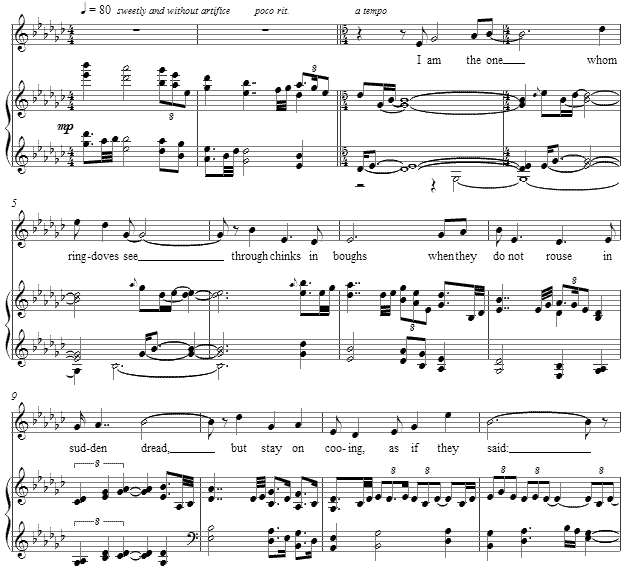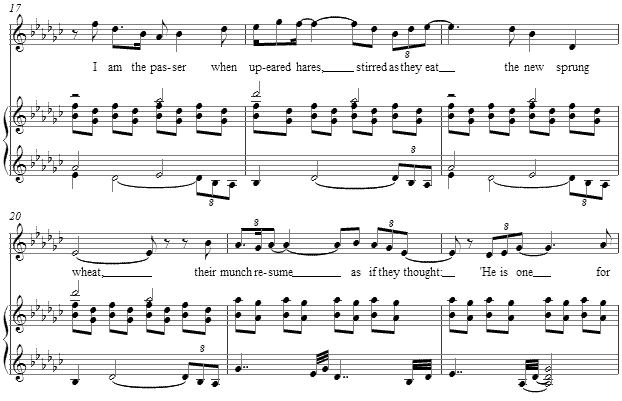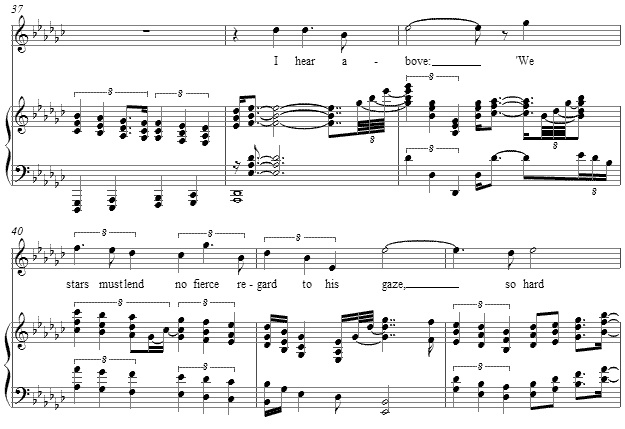Music and Texts of GARY BACHLUND
Vocal Music | Piano | Organ | Chamber Music | Orchestral | Articles and Commentary | Poems and Stories | Miscellany | FAQs
'I Am the One' - (2003)
Thomas Hardy
for mezzo soprano and piano
for mezzo soprano Stephanie Houtzeel
I am the one whom ringdoves see
Through chinks in boughs
When they do not rouse
In sudden dread,
But stay on cooing, as if they said:
'Oh; it's only he.'
I am the passer when up-eared hares,
Stirred as they eat
The new sprung wheat,
Their munch resume
As if they thought: 'He is one for whom
Nobody cares.'
Wet-eyed mourners glance at me
As in train they pass
Along the grass
To a hallowed spot,
And think: 'No matter; he quizzes not
Our misery.'
I hear above: 'We stars must lend
No fierce regard
To his gaze, so hard
Bent on us thus, --
Must scathe him not, He is one with us
Beginning and end.[ 4 pages, circa 3' 15" ]
Thomas Hardy
This musing about God, whether one be a believer or not, takes the form of an affirmation in God, while seeming to minimize any notion of deity until the last verse wherein the very stars themselves affirm "He is one with us" mixed alongside the citation of "beginning and end," an iconic reference to the theological reference as one sees in the Greek "Alpha" and "Omega."
In the modern and very amusing public debate over belief, the cant from the atheist is that God cannot be proven, or is best seen as replaced by science. This notion is, of course, naive, even in the most "sophisticated" thinkers who stumble over the same old arguments which have existed for centuries. Belief remains belief, in the human heart, and is not within the province of science anymore than science is within the province of religion. For those who pour out their human urge to believe by thinking that science is something in which to believe fall into the 'category error' of which Gilbert Ryle so well mused.
Belief is other than science, and this poem's images, beginning with the citation of "I am the one" in the title and its stanza's repeated references to at least a minimal God which ringdoves, hares, mourners at a funeral and even the stars suggest that the poet sees something of this "I am the one" which he tells us birds and rabbits see. Why does the atheist in his "credo" reject the notion of God in some form? Hardy tells us it is because of anger; "he quizzes not our misery." The author observes this about man -- us -- in a poem about "the one" who is "with us / Beginning and end."
It is the same kind of belief one finds in the libretto for Verdi's Otello, in which Iago's "profession of faith" overtly states "I believe in a cruel God" which brings "nothing." An important characteristic of Iago is that he sees himself as made like unto the image of the god he professes -- cruel. Atheism's continual musing about the nothingness of God has always amused me because of its continued focus on God, by repetitively affirm there in none.
The most truthful nonbeliever would not bother to rage nor even take the time and words to observe -- "he quizzes not / Our misery" for there would be no "he" and this poem would have no sense. Hardy's artistic choice to write this poem evidences his relationship to "I am the one" which Hardy concludes is "with us / Beginning and end." These are not the words of the hard-edged atheist, but of an artist who too sees "our misery" and wonders aloud in verse about the "I am the one" for whom "nobody cares." The text is therefore evidence in of itself -- res judicata -- for its title and focus on the entity of which Hardy writes, "I am the one."
The opening gesture is marked as "sweet and without artifice." The four note chords which accompany the vocal setting bring a touch of modernity to the setting itself, and yet the "pastoral" consonance of them also harkens back to Hardy's era.
The second stanza of the poem becomes a bit more rhapsodic, intended to move the seeming urgency of the text forward. The images Hardy chooses are from nature -- ringdoves in the brush, hares in the field, men in the cemetery, and finally stars in the heavens -- bringing a heightened sense to the argument that spans between "beginning and end."
At the point at which Hardy conjures the stars to testify, the setting becomes yet more rhapsodic with bolder triplets across the half measure and the vocal line rising to its highest point. The setting ends with a quiet affirmation drawn from the initial gestures of the song, the spreading perfect fifths giving testimony to the timelessness of the "One."
Stephanie Houtzeel
Stephanie Houtzeel earned her BA in Political Science and French from Middlebury College, Vermont, and her Masters of Music from the Juilliard School. She was born in Kassel, Germany to German-Dutch parents and grew up near Boston, Massachusetts. She began her operatic career in Linz, Austria, and in Germany, where her roles at the Opera in Linz included Rosina, Cenerentola, Cherubino, Meg Page, Suzuki and, at the Hersfelder Festspiele, Octavian and Dorabella. She has appeared most recently in Zurich, Antwerp, Graz and St. Gallen. Also active in the Baroque repertoire, she sang the title role in Handel's Ariodante and Galatea in Acis and Galatea with the Opera da camera Linz, toured for the first time with the Collegium Vocale Gent, toured regularly with the Four Nations Ensemble of New York. Her recording of Handel cantatas, with the Bouts Baroque Ensemble, received high praise from the American Record Review and Classics Today.
The score to I Am the One in this medium key is available as a free PDF download, though any major commercial performance or recording of the work is prohibited without prior arrangement with the composer. Click on the graphic below for this piano-vocal score.




